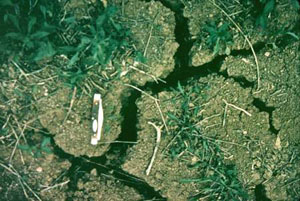Soil Science Society of America
5585 Guilford Road • Madison, WI 53711-5801 • 608-273-8080 • Fax 608-273-2021
www.soils.org
Twitter | Facebook
NEWS RELEASE
Contact: Hanna Jeske, Associate Director of Marketing and Brand Strategy, 608-268-3972, hjeske@sciencesocieties.org
Causes of cracking soil
June 25, 2014--In areas affected by drought, residents may be seeing more cracks in their soil. Are these serious?
According to Eric Brevik, a professor at Dickinson State University, some soils have a high content of clay minerals known as smectites. When smectite clays get wet, water moves into a space between the structural units that make up the clay mineral. The presence of the water molecules pushes the structural units apart, causing the clay mineral to expand, or swell.

Vertisol showing large cracks during a dry period. Note the pocket knife for scale. Photo: Soil Science Society of America Marbut slide collection.
When these clays dry out, the water molecules are removed from the inter-structural spaces and the clays shrink. When this shrinking takes place in millions of clay structural units in a volume of soil, the shrinking can be enough to create large cracks in the soil. Soils with a high shrink-swell clay content are known as Vertisols.
Vertisols are found in several places in the United States, including the Gulf Coastal Plain of Texas, the Mississippi River Valley from Illinois to the Gulf Coast, central Montana, western South Dakota, and the Red River Valley of North Dakota and Minnesota. Other major Vertisol regions in the world include central India, eastern Australia, and eastern Sudan and South Sudan.
For more information about soils and gardening, conservation, food, and more, visit the Soils Matter blog sponsored by the Soil Science Society of America at soilsmatter.wordpress.com. SSSA also has public information on its website, soils.org/discover-soils.